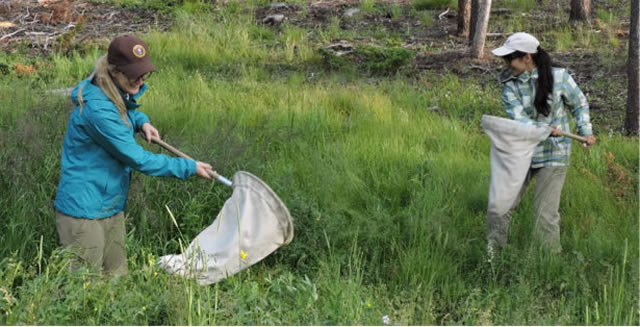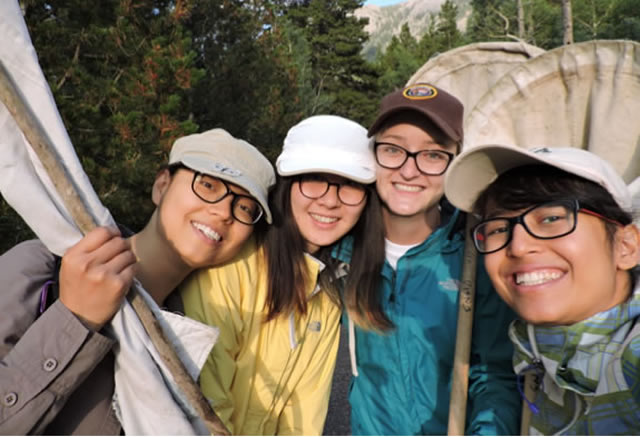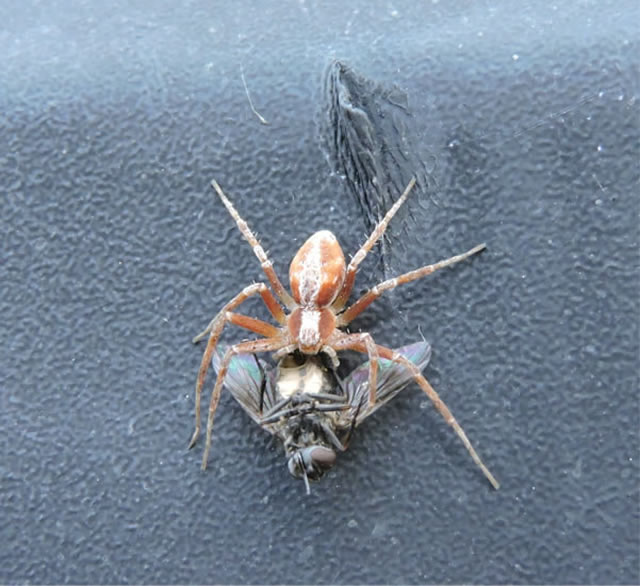We are graduate students from the Nicholas School of the Environment at Duke University working this summer as E.O. Wilson Biodiversity Foundation interns, as part of the ATBI/BioBlitz SWAT Team and Group Masters Project. Our work is supported by a partnership with Discover Life in America, Rocky Mountain National Park, and the Turner Endangered Species Fund. This summer we will be identifying gaps in the current species database at Rocky Mountain National Park. From our experiences we ultimately hope to develop a story that inspires action to preserve biodiversity in our national parks and natural spaces.
ATBI/BioBlitz SWAT Team: Week 7 in Rocky Mountain National Park
These past two weeks have truly been hectic for our team but it has been a rewarding experience. As you read in our last blog post, we have chosen to conduct a preliminary spider survey in the park. We met with Paula Cushing at the Denver Museum of Nature and Science (DMNS) and she was very excited to be working with us on our project! She offered her invaluable advice on how we should design our spider survey. She gave us her handbook on conducting spider surveys in Colorado and recommended dichotomous keys that can be used to identify spiders. Our team will generally not be able to identify our spider specimens to the species level, as that requires extensive expertise, so we will attempt to identify them to the best of our abilities. After that, Paula and her team at the DMNS will identify the specimens to the species level, if possible.
We went over the equipment required for the methods to collect specimens. Paula graciously lent us sweep nets, beat sheets, and a Berlese funnel to conduct our survey in RMNP. Sweep nets are used for “look up” and “look down” collection in vegetation such as grasses and trees. Beat sheets are made of white cloth and are used to pick out spiders after beating vegetation or branches above them. A Berlese funnel is used to collect spiders in leaf litter and it uses heat to extract the spiders from the litter. One of the most important considerations while we are collecting spiders is that we only collect mature specimens. Paula showed us how to distinguish juvenile spiders from mature spiders, with both male and female organisms. All the spiders that are collected are preserved in 75% ethanol and will be identified in the months following the survey, with the aid of the DMNS. The pictures below showcase these creative methods of spider collection!




After receiving all this information, we set out to design a spider survey in the park. We selected three locations to survey in the park: Lily Lake, Hidden Valley, and McGraw Ranch. All these locations are in the front-country, meaning that they are not in designated wilderness. This was an important aspect of our project because it is much more difficult and time taking to receive a permit from the park for studies in wilderness areas. Lily Lake and McGraw Ranch are riparian locations whereas Hidden Valley is primarily composed of subalpine forest. We decided to actively survey for one hour, excluding the time we are stopped to examine the spiders we have collected. The surveys are therefore time dependent, and not transect length dependent; we go as far as we can in a one-hour time frame.
We have three windows in a day to conduct our surveys: morning (7-9 am), afternoon/evening (3-6 pm), and night (10 pm – 12 am). This is essential because different species of spiders are active at various times during the day and night. Many spiders are nocturnal so we would be missing a large number of species if we did not conduct night surveys. All these factors were discussed with our supervisors at RMNP so that our permit application could be approved and we could conduct a successful preliminary survey in the park.
Our first few days of surveying went surprisingly well! We collected on average 15-20 individuals per transect and we were able to get different types of spiders. Two of our group members were slightly arachnophobic but they quickly became accustomed to having all sorts of critters around them. This is a really great example of how being around spiders and learning about how important they are to the ecosystem can make them less scary. One of the goals of our project is to tie the importance of our research on spiders to the overall importance of biodiversity in the park. These types of connections are crucial to the “so what” question and can help make biodiversity research a priority in the park!


—Sahil Chaini, Zhenzhen Chen, Casey Johnson, and Jianyu Wu

